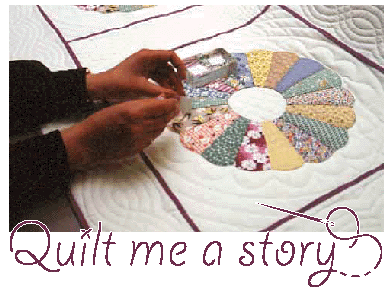


|

|
It was started in memory of her mother who passed away this summer: a quilt with patches of 28 pairs of hands belonging to family members, children, grandchildren and great-grandchildren, cut out from cloth they each selected for the quilt.
"It will stay at the family cottage at the lake when it's done," says Dr. Elizabeth Richards, a professor in human ecology. The quilt is still in the making because Richards was concentrating on completing her PhD at the U of A in textile science. A picture of her parents on their wedding day is at the centre, and heart, of the family quilt.
Quilting is experiencing a huge resurgence these days, says Richards. "It's a craft, a form of expression for women, and it's fun to do." It's also a way for people to share their stories in a supportive environment, she says, and "it's a great hobby."
It must be more than just a hobby. A recent quilt show at the Chateau Louis in Edmonton attracted about 2,000 people, and the Alberta Craft Council has an exhibit on until Nov. 7, 1998. A woman at the council said the "artists" will be available on opening night.
Indeed, looking at the many glorious quilts in the U of A's collection, it's easy to see how putting a needle and thread together with a variety of materials can result in some spectacular pieces.
"It's one form of fibre art," says Richards. Some people may snicker, thinking it's on the lowest rung of the ladder of fibre art after weaving and embroidering. But many people look at quilts as beautiful artifacts, not just crafts.
"Quilts tell us about social history," says Richards. Prior to the 19th century, it was important for women to have a hope chest full of quilts in preparation for upcoming nuptials. Quilts were also sewn together out of necessity, using left over material scraps, or, in one case in the U of A collection, fabric from old men's suits. Making quilts in the olden days, and even today, was a means of socializing for women. Neighbors would get together to help one another finish quilts. Remember the movie, How to Make an American Quilt? You get the drift.
Initially, says Richard, quilting was a hobby for the wealthy and upper classes who would purchase and import fine expensive materials for their craft. Women were practicing their needlework skills, not worrying about the functional qualities of their work. While it appears to have a grounding in European and Eastern cul-tures, like British, Italian and Japanese, Richards says it's popularity grew because of North American interest, when women settlers began making quilts out of small pieces for their families. The advent of the sewing machine in the 1850s and the availability of cotton fabrics spurred more quilt production since women were now relieved of weaving their own yarns to make materials. With one obstruction out of the way, the focus turned to other things.
Richards can easily identify how old quilts are by patterns, fabrics and stitching. "It was not common for quilts to be embroidered until the '20s and '30," she says. She points to another and says the print size and color of its fabric show it was made in the '40s. You can identify an antique quilt, which can fetch up to $4,000 dollars among collectors, because of the brown tones and pink-on-pink colors, she says.
"There are not a lot of old quilts in Alberta, unless they were brought here, because it's a young province. But we do see a lot of quilts from the Depression era." At that time women couldn't wait to cut out patterns in their local newspaper, many of which were syndicated columns, and get together in their groups, she says.
And when women weren't quilting for themselves, they did it for others. One bachelor in the 1940s commissioned a quilt from a woman who made one with an obvious sense of humor-a series of women prancing with their parasols. The professor laughs: "Think of all those ladies at once on his bed!"
Another quilt in the clothing and textiles collection carries a quieter tone. Made for a baby, it's in perfect condition, says Richards. "The baby probably died. It was hardly used." The Richards' family quilt, however, will warm many a family member on a cold and rainy day at the cottage.

Folio front page |

Office of Public Affairs |

University of Alberta |